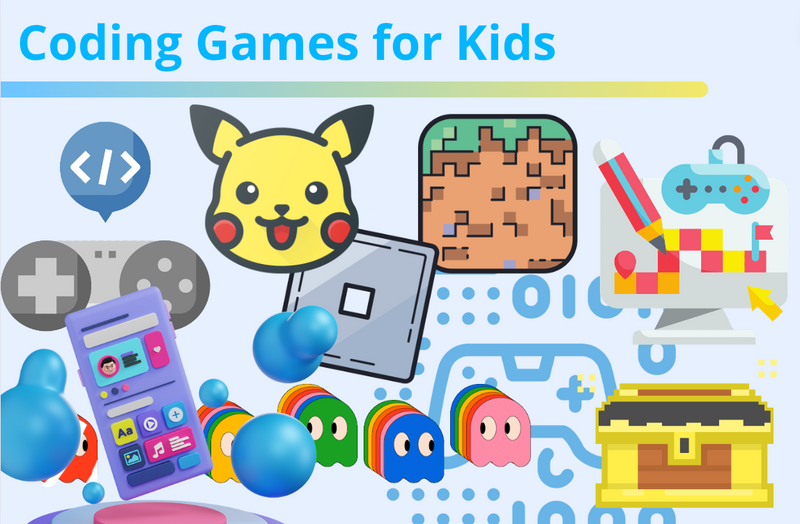Summer is the perfect season for exploration and learning, especially when it comes to engaging the curious minds of young learners in the fascinating world of Science, Technology, Engineering, and Mathematics (STEM). Explore a treasure trove of STEM summer activities tailored for children, ranging from growing dazzling rock candy, learning the cycle of water, and shadow drawing, to learning coding with summer STEM camps. Each activity is designed to spark creativity, foster critical thinking, and encourage building problem solving skills.
Get started right away with a free beginner-friendly Scratch coding class for kids:
Discover Summer STEM Activities for Elementary Students
Whether it's through hands-on experiments that can be done at home or interactive sessions with peers under the guidance of expert instructors, these STEM opportunities are a gateway for kids to discover new interests and talents. So, get ready to dive into a summer of discovery, where the worlds of science and imagination blend seamlessly, promising something exciting and enriching for every young explorer out there.
1. Water Cycle Bag
Learn all about evaporation with a fun activity from the Oklahoma Science Museum. A sealed bag with water taped to a window simulates the water cycle. Kids observe evaporation, condensation, and precipitation. It's an effective visual tool for understanding the water cycle and environmental science.
Steps:
- Fill a sealable plastic bag with water and a bit of blue food coloring.
- Tape the bag to a sunny window.
- Watch and record the water cycle in action over days.
2. Candy Bar Geology
The "Edible Rocks" activity, inspired by resources from NASA's Jet Propulsion Laboratory (JPL), offers a deliciously hands-on way to learn about geology and the rock cycle. By creating and comparing edible rocks made from different ingredients such as chocolate chips, marshmallows, and cereal, children can understand the formation and classification of igneous, sedimentary, and metamorphic rocks. This activity not only makes complex scientific concepts accessible but also stimulates the senses, making learning a full-bodied experience. It's perfect for young geologists who enjoy interactive and tasty science lessons.
Steps:
- Gather ingredients representing various types of rocks: chocolate chips for igneous rocks, marshmallows for sedimentary rocks, and cereal for metamorphic rocks.
- Following the JPL guidelines, melt, layer, and press the ingredients to mimic the rock formation processes: melting and cooling for igneous, layering and pressing for sedimentary, and heating and pressing without melting for metamorphic.
- Once the edible rocks have formed, discuss the different processes and types of rocks with the children, encouraging them to observe and note the similarities and differences between their creations and real rock samples.
3. Plant Growth Experiment
In this experiment from the US Department of Agriculture, kids can plant seeds under various conditions (light, no light, different soils) to observe growth differences. This activity introduces basic botany and the scientific method. It's perfect for teaching about plant needs and experimental variables.
Steps:
- Plant identical seeds in multiple pots with different growing conditions.
- Water them equally and place some in sunlight and others in dark.
- Observe and record growth over several weeks.
4. Homemade Lava Lamps
Making temporary lava lamps is a fun, colorful and easy science experiment sure to keep your kids engaged and entertained, all while learning about basic chemical reactions. By mixing vegetable oil, water, food coloring, and Alka-Seltzer, children create a bubbly lava lamp, following directions from the Minnesota Children's Museum. It's an engaging way to explore the concepts of density and chemical reactions. Kids love watching the colorful bubbles move up and down.
Steps:
- Fill a clear bottle most of the way with vegetable oil.
- Add water, leaving some space at the top, and a few drops of food coloring.
- Drop in an Alka-Seltzer tablet and watch the lava lamp come to life.
5. Rock Candy Crystals
By growing their own rock candy, children can explore the fascinating world of supersaturation and crystal formation. Using just sugar and water, they can observe how crystals grow over time, providing a sweet lesson in patience and scientific observation. This delicious experiment not only demonstrates key chemistry concepts but also results in a tasty treat that kids can customize with their favorite colors and flavors. Follow these steps from the Orlando Science Center.
Steps:
- Dissolve a large amount of sugar in boiling water to create a supersaturated solution. For every cup of water, use about 3 cups of sugar.
- Add food coloring or flavoring to the solution to customize your candy.
- Pour the solution into a jar and suspend a skewer or string in the center, making sure it doesn't touch the sides or bottom. To initiate crystal growth, you can roll the skewer in sugar before placing it in the solution.
- Leave the jar in a cool, undisturbed place and wait for crystals to form on the string or skewer, which can take a few days to a week. The evaporation of water from the solution encourages the sugar to recrystallize, forming rock candy.
6. Balloon Rocket Race
Kids use balloons, straws, and string to create a simple rocket. This activity from National Geographic teaches principles of aerodynamics and Newton's third law of motion. It's a fun, competitive way to learn about physics and forces.
Steps:
- Thread a straw onto a long piece of string and tie the string between two chairs.
- Inflate a balloon without tying it and tape it to the straw.
- Release the balloon and watch it zoom along the string.
7. Shadow Drawing
Children use toys or other objects to cast shadows on paper, which they trace throughout the day. This illustrates how the Earth's rotation affects sunlight and shadows. It's a creative way to learn about astronomy and the concept of time. You can follow these steps from the Sun Valley Museum of Art.
Steps:
- Place a toy near a paper on a sunny spot.
- Trace the shadow at different times.
- Compare the shadow lengths and positions.
8. Magnetic Maze Creation
Using a magnet, paper clips, and a cardboard base, kids create and navigate a maze. This introduces magnetism and forces in a hands-on way. It's great for problem-solving and understanding magnetic fields. Here are a few simple steps to follow.
Steps:
- Design a maze on cardboard and place paper clips along the paths.
- Use a magnet under the cardboard to guide a clip through the maze.
- Experiment with different maze designs and challenges.
9. Online STEM summer camps
Create & Learn offers award-winning online STEM summer camps designed specifically for young learners by professionals from Google, Stanford, and MIT. These camps cover a wide range of topics from coding, artificial intelligence, and robotics to digital art and science. By participating, kids can explore new areas of interest, develop critical thinking and problem solving skills, and connect with peers who have similar interests. The camps are led by expert instructors who specialize in making learning fun and engaging, ensuring that each child receives a quality education tailored to their age and skill level.
Steps:
- Explore the different STEM camps available. Look for camps that match your child's interests and age group. Start with a free camp session.
- Register for the chosen camp(s), making note of the dates and times. Ensure you have any required materials or technology ready ahead of time.
- Encourage your child to participate actively and ask questions during the camp sessions. Afterward, discuss what they learned and how they can apply it to other areas of interest or further learning opportunities.
10. In-person STEM Camps
Activity Hero hosts a diverse array of in-person STEM summer camps provided by various organizations. These camps offer hands-on learning experiences in fields like engineering, computer science, robotics, and more. Attending these camps not only enhances children's STEM skills but also fosters social interaction and teamwork. They're perfect for kids who thrive in a collaborative environment and are eager to explore STEM fields in a more tactile and interactive setting. Providers are vetted, ensuring a safe and enriching experience for all attendees.
Steps:
- Navigate to the Activity Hero website and use their search feature to find in-person STEM camps. You can filter results based on your child's age, interests, and your location to find the perfect match.
- Review the camp descriptions, dates, locations, and reviews to select the best fit for your child. Pay attention to any specific requirements or materials needed.
- Register your child for the camp(s) of your choice directly through the Activity Hero platform. Prepare for the camp by gathering any necessary items and discussing what to expect with your child, emphasizing the fun and learning to come.
Enjoy Summer STEM Activities
This summer, let's turn those lazy days into a journey of discovery, where kids can laugh, learn, and leap into the vast world of STEM, ready to be the innovators of tomorrow.
You might also enjoy creative spring STEM activities.




